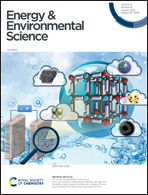Peripheral halogenation engineering controls molecular stacking to enable highly efficient organic solar cells†
Abstract
The diverse molecular stacking tuned by peripheral halogens in non-fullerene acceptors (NFAs) significantly affects the molecular physicochemical properties, the film morphologies and thus the power conversion efficiencies (PCEs) of organic solar cells (OSCs). Despite the crucial role of peripheral halogens, few explorations have been performed to bridge peripheral halogenation with molecular stackings and device performances, especially for the state-of-the-art Y-series. Herein, a series of high-efficient NFAs, CH-6F, CH-4Cl and CH-6Cl, are constructed with the same backbone but different peripheral halogenations in both conjugate extended central units and end groups. Single-crystal analysis indicates that CH-6F possesses similar molecular packings to Y6; however, CH-4Cl and CH-6Cl with chloro-substitutions demonstrate several quite unique packing modes of end unit to central unit, etc. Compared with CH-6F and Y6, CH-4Cl and CH-6Cl possess greatly reduced electron reorganization energies and shorter intermolecular packing distances, and exhibit more balanced charge mobilities, better phase separation, and lower energy disorders when blended with the PM6 donor. Furthermore, the reduced energy offsets between charge transfer and local exciton states for CH-4Cl and CH-6Cl result in an enhanced hybridization of these two states and thus suppress the non-radiative recombination losses in OSCs. Consequently, high-efficient OSCs are afforded by utilizing CH-series NFAs with a champion PCE of 18.22% and a markedly reduced ΔVnr of 0.203 V in CH-4Cl-based ternary devices. Our study reveals that such a slight modification of peripheral halogens could cause quite different but superior intermolecular packings, rendering peripheral halogenation engineering as an effective strategy to further boost PCEs of high-performance OSCs through delicate molecular stacking control.



 Please wait while we load your content...
Please wait while we load your content...